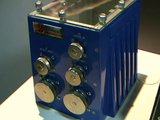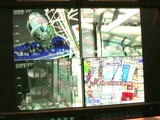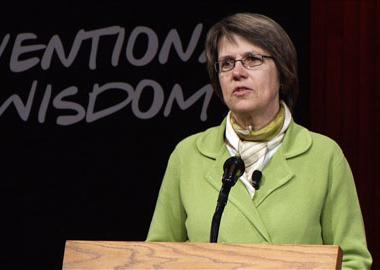Latest Videos
Engineering TV : Most Recent >>
 Curtis Reichenfeld, CTO of Curtiss-Wright Electronic Systems, showcases some of their newest integrated electronics for military and aerospace applications, including a compact flight control computer, the next generation single board computer for the Global Hawk UAV, a conduction-cooled 3U VPX chassis and more.
Curtis Reichenfeld, CTO of Curtiss-Wright Electronic Systems, showcases some of their newest integrated electronics for military and aerospace applications, including a compact flight control computer, the next generation single board computer for the Global Hawk UAV, a conduction-cooled 3U VPX chassis and more.
 Curtis Reichenfeld, CTO of Curtiss-Wright Electronic Systems, showcases some of their newest integrated electronics for military and aerospace applications, including a compact flight control computer, the next generation single board computer for the Global Hawk UAV, a conduction-cooled 3U VPX chassis and more.
Curtis Reichenfeld, CTO of Curtiss-Wright Electronic Systems, showcases some of their newest integrated electronics for military and aerospace applications, including a compact flight control computer, the next generation single board computer for the Global Hawk UAV, a conduction-cooled 3U VPX chassis and more.
Hosted by: Bill Wong Videography by: Curtis Ellzey Edited by: Curtis Ellzey
Engineering TV : Most Recent >>
 Designed to meet the needs of military research and training programs for UAVs such as Predator and Reaper drones, the Reaper Ground Control Simulator from CH Products features industrial grade components, driverless USB connectivity, and is capable of supporting a wide variety of simulation software.
Designed to meet the needs of military research and training programs for UAVs such as Predator and Reaper drones, the Reaper Ground Control Simulator from CH Products features industrial grade components, driverless USB connectivity, and is capable of supporting a wide variety of simulation software.
 Designed to meet the needs of military research and training programs for UAVs such as Predator and Reaper drones, the Reaper Ground Control Simulator from CH Products features industrial grade components, driverless USB connectivity, and is capable of supporting a wide variety of simulation software.
Designed to meet the needs of military research and training programs for UAVs such as Predator and Reaper drones, the Reaper Ground Control Simulator from CH Products features industrial grade components, driverless USB connectivity, and is capable of supporting a wide variety of simulation software.
Hosted by: Bill Wong Videography by: Curtis Ellzey Edited by: Curtis Ellzey
Engineering TV : Most Recent >>
 Curtiss-Wright's Skyquest ALPHA series of rugged standalone video displays feature a wealth of surveillance features such as FLIR, long range daylight video cameras, moving maps, computers and radar. Skyquest CTO Anthony McQuiggan showcases their AVDU-5008 20", ideal for integrating into today's airborne military and search & rescue platforms.
Curtiss-Wright's Skyquest ALPHA series of rugged standalone video displays feature a wealth of surveillance features such as FLIR, long range daylight video cameras, moving maps, computers and radar. Skyquest CTO Anthony McQuiggan showcases their AVDU-5008 20", ideal for integrating into today's airborne military and search & rescue platforms.
 Curtiss-Wright's Skyquest ALPHA series of rugged standalone video displays feature a wealth of surveillance features such as FLIR, long range daylight video cameras, moving maps, computers and radar. Skyquest CTO Anthony McQuiggan showcases their AVDU-5008 20", ideal for integrating into today's airborne military and search & rescue platforms.
Curtiss-Wright's Skyquest ALPHA series of rugged standalone video displays feature a wealth of surveillance features such as FLIR, long range daylight video cameras, moving maps, computers and radar. Skyquest CTO Anthony McQuiggan showcases their AVDU-5008 20", ideal for integrating into today's airborne military and search & rescue platforms.
Hosted by: Bill Wong Videography by: Curtis Ellzey Edited by: Curtis Ellzey
MIT World: Engineering >>
 While automakers market increasingly intelligent cars, they may be missing the point. No matter how sophisticated the vehicle’s brain, suggests
While automakers market increasingly intelligent cars, they may be missing the point. No matter how sophisticated the vehicle’s brain, suggests
Alex (Sandy) Pentland, the smartest element on the road is still the human driver. In search of safe, responsive vehicles, designers should not think of separate components -- machine and operator -- but rather, an integrated system comprised of two, complementary intelligences.
Tackling this challenge involves analyzing human behavior -- not the traditional purview of engineers who “are scared off by the noise, the randomness of people.” Pentland, on the other hand, has long explored human decision-making in a variety of settings, including car driving. Working with an automaker, he outfitted test vehicles with sensors on the steering wheel, brakes and elsewhere, to “determine predictive signals of driving.” The sensors permitted the analysis of “clusters of behaviors,” so Pentland could figure out with 95% accuracy “what people would do before they did it.” From developing a model of the driver’s behavior, he moved on to neighboring drivers’ patterns, to paint a picture of road interactions and signaling.
This research has resulted in a system now
 While automakers market increasingly intelligent cars, they may be missing the point. No matter how sophisticated the vehicle’s brain, suggests
While automakers market increasingly intelligent cars, they may be missing the point. No matter how sophisticated the vehicle’s brain, suggests Alex (Sandy) Pentland, the smartest element on the road is still the human driver. In search of safe, responsive vehicles, designers should not think of separate components -- machine and operator -- but rather, an integrated system comprised of two, complementary intelligences.
Tackling this challenge involves analyzing human behavior -- not the traditional purview of engineers who “are scared off by the noise, the randomness of people.” Pentland, on the other hand, has long explored human decision-making in a variety of settings, including car driving. Working with an automaker, he outfitted test vehicles with sensors on the steering wheel, brakes and elsewhere, to “determine predictive signals of driving.” The sensors permitted the analysis of “clusters of behaviors,” so Pentland could figure out with 95% accuracy “what people would do before they did it.” From developing a model of the driver’s behavior, he moved on to neighboring drivers’ patterns, to paint a picture of road interactions and signaling.
This research has resulted in a system now
MIT World: Engineering >>
 Four women who have made ground-breaking contributions in different disciplines describe their research, which has not only involved ‘thinking outside the box,’ but in some cases persevering in the face of skepticism.
Four women who have made ground-breaking contributions in different disciplines describe their research, which has not only involved ‘thinking outside the box,’ but in some cases persevering in the face of skepticism.
Two presenters work on the frontier of biological systems and materials science, and find both inspiration and practical subject matter in aquatic life forms. For Angela Belcher, the abalone offers a model for development of organic/inorganic hybrid structures. The shell of this creature, which is 3000 times tougher than its purely geological counterpart, consists of stacks of calcium carbonate in precise geometries, made from just 20 different amino acids, says Belcher. Some years ago, she had the insight that it might be possible to fabricate hybrid materials, kind of like an abalone, “at a living/nonliving interface.” She set about creating an organism that could build structures like battery electrodes, using bacterial hosts injected with viruses that had an affinity for a particular material. “When I said I was trying to develop a genetic link between semiconductor materials and biology, I was told I was insane,” says Belcher. “But it came out OK.” Undaunted, Belcher is now developing
 Four women who have made ground-breaking contributions in different disciplines describe their research, which has not only involved ‘thinking outside the box,’ but in some cases persevering in the face of skepticism.
Four women who have made ground-breaking contributions in different disciplines describe their research, which has not only involved ‘thinking outside the box,’ but in some cases persevering in the face of skepticism.Two presenters work on the frontier of biological systems and materials science, and find both inspiration and practical subject matter in aquatic life forms. For Angela Belcher, the abalone offers a model for development of organic/inorganic hybrid structures. The shell of this creature, which is 3000 times tougher than its purely geological counterpart, consists of stacks of calcium carbonate in precise geometries, made from just 20 different amino acids, says Belcher. Some years ago, she had the insight that it might be possible to fabricate hybrid materials, kind of like an abalone, “at a living/nonliving interface.” She set about creating an organism that could build structures like battery electrodes, using bacterial hosts injected with viruses that had an affinity for a particular material. “When I said I was trying to develop a genetic link between semiconductor materials and biology, I was told I was insane,” says Belcher. “But it came out OK.” Undaunted, Belcher is now developing
MIT World: Engineering >>
 Although these three speakers travel in quite disparate worlds -- natural language processing, mechanics of tiny organisms, and violent cosmic events -- they convey a comparably infectious enthusiasm for their research.
Although these three speakers travel in quite disparate worlds -- natural language processing, mechanics of tiny organisms, and violent cosmic events -- they convey a comparably infectious enthusiasm for their research.
In the early days of artificial intelligence, “people had the naïve idea that if you took a computer, and fed it with enough human knowledge, it could eventually understand human language,” relates Regina Barzilay. In the 1990s, after this “spectacular failure” in methodology, a new approach evolved: training a machine to infer knowledge from piles of data. Some successes are already in evidence (IBM’s chess- and Jeopardy-playing programs). Barzilay wants to move this learning further, toward “grounding interpretation of language in the real world.” She describes algorithms that could take over the often exasperating grunt work of installing new Windows software on computers, by reading common instructions and executing the actions. Her system learns to map words with increasing accuracy by using feedback. She is also investigating how to get a machine to understand and act in a much more complex environment, such as the Civilization computer game. Using simulations, her algorithms make predictions about the best possible
 Although these three speakers travel in quite disparate worlds -- natural language processing, mechanics of tiny organisms, and violent cosmic events -- they convey a comparably infectious enthusiasm for their research.
Although these three speakers travel in quite disparate worlds -- natural language processing, mechanics of tiny organisms, and violent cosmic events -- they convey a comparably infectious enthusiasm for their research.In the early days of artificial intelligence, “people had the naïve idea that if you took a computer, and fed it with enough human knowledge, it could eventually understand human language,” relates Regina Barzilay. In the 1990s, after this “spectacular failure” in methodology, a new approach evolved: training a machine to infer knowledge from piles of data. Some successes are already in evidence (IBM’s chess- and Jeopardy-playing programs). Barzilay wants to move this learning further, toward “grounding interpretation of language in the real world.” She describes algorithms that could take over the often exasperating grunt work of installing new Windows software on computers, by reading common instructions and executing the actions. Her system learns to map words with increasing accuracy by using feedback. She is also investigating how to get a machine to understand and act in a much more complex environment, such as the Civilization computer game. Using simulations, her algorithms make predictions about the best possible
MIT World: Engineering >>
 With many years of academic and corporate workplace experience among them, these panelists share expertise and best practices for recruiting and retaining women to science and engineering careers.
With many years of academic and corporate workplace experience among them, these panelists share expertise and best practices for recruiting and retaining women to science and engineering careers.
Mildred Dresselhaus came to MIT to teach physics to engineering students. Although she received a scholarship funding women in science, she always believed “it was important for men to take you seriously, and not to worry about your sex.” Dresselhaus feels she “works for her students, and they work for her,” and says she learned a lot about teaching and providing for students’ careers from her years as a mother to four children. She believes mentoring serves an important function on campus, for men and women, and that it can prove particularly helpful to women, who may lack self-confidence. Her mentoring, which includes weekly meetings with some young women faculty, emphasizes some basic ideas, such as curiosity, creativity, being skeptical and thinking innovatively. She also wants her protégées to learn how to “handle disappointment,” since work “at the cutting edge doesn’t work most of the time.” She is particularly sympathetic to the challenges of combining work and family life, which still
 With many years of academic and corporate workplace experience among them, these panelists share expertise and best practices for recruiting and retaining women to science and engineering careers.
With many years of academic and corporate workplace experience among them, these panelists share expertise and best practices for recruiting and retaining women to science and engineering careers.Mildred Dresselhaus came to MIT to teach physics to engineering students. Although she received a scholarship funding women in science, she always believed “it was important for men to take you seriously, and not to worry about your sex.” Dresselhaus feels she “works for her students, and they work for her,” and says she learned a lot about teaching and providing for students’ careers from her years as a mother to four children. She believes mentoring serves an important function on campus, for men and women, and that it can prove particularly helpful to women, who may lack self-confidence. Her mentoring, which includes weekly meetings with some young women faculty, emphasizes some basic ideas, such as curiosity, creativity, being skeptical and thinking innovatively. She also wants her protégées to learn how to “handle disappointment,” since work “at the cutting edge doesn’t work most of the time.” She is particularly sympathetic to the challenges of combining work and family life, which still



